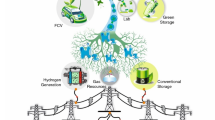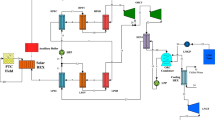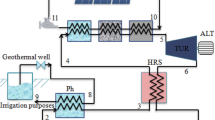Abstract
This study presents a hybrid solar–geothermal power plant to produce power, heating and cooling. The proposed integrated power plant is composed of a flash–binary geothermal cycle, parabolic trough solar collectors, auxiliary heater, single effect LiBr–water absorption chiller and heat exchangers. The plant produces constant electrical power as well as heating and cooling required for a yeast production factory. The energetic and exergetic efficiencies of the solar–geothermal power plant for the proposed system under the steady-state condition with constant irradiance are evaluated at 10.78% and 23.1%, respectively. It also found that most of the exergy destruction in the power plant occurs inside solar collectors and auxiliary heaters. It was calculated that heat exchanger three and an absorption chiller would produce 1.97 MW of power, 4.03 MW of heat and 563.2 kW of cooling. Moreover, the variation of evaluation parameters based on the changes in solar beam irradiance is investigated. It found that increasing beam irradiance will result in increasing total exergy efficiency and reducing \(\dot{C}_{{{\text{tot}}}}\), in constant heat input to the cycle. The share of the auxiliary heater in the plant’s energy-providing and the fuel’s mass flow rate would be decreased by increasing the solar beam irradiance.













Similar content being viewed by others
Abbreviations
- Cond:
-
Condenser
- CCHP:
-
Combined cooling, heat and power
- COP:
-
Coefficient of performance
- EUF:
-
Energy utilization factor
- Exh:
-
Exhaust
- LHV:
-
Lower heating value
- HRSG:
-
Heat recovery steam generator
- ORC:
-
Organic Rankine cycle
- PVT:
-
Photovoltaic–thermal
- A:
-
Area (m2)
- abs:
-
Absorber
- bt:
-
Binary turbine
- Cp:
-
Specific heat
- D :
-
Diameter (m)
- D O :
-
Collector tube outlet diameter (m)
- e.v:
-
Expansion valve
- e :
-
Specific exergy (kJ kg−1), evaporator
- \(\dot{E}\) :
-
Exergy rate (kJ)
- \(\dot{E}_{{\text{D}}}\) :
-
Exergy destruction rate (kW)
- h :
-
Specific enthalpy (kJ kg−1)
- I b :
-
Beam irradiance (W m−2)
- K :
-
Component
- m :
-
Mass flow rate (kg s−1)
- M :
-
Molecular mass \(\left( {{\text{kg}} \, {\text{kmol}}}^{-1} \right)\)
- n :
-
Number of solar collectors, day number
- P :
-
Pressure (bar), pump
- Q :
-
Heat transfer (kJ)
- \(\dot{Q}\) :
-
Heat transfer rate (kW)
- \(\dot{Q}_{{\text{u}}}\) :
-
Useful heat gain (kW)
- S :
-
Absorbed heat (kJ)
- s :
-
Specific entropy (kJ kg−1 K−1)
- T :
-
Temperature/turbine (K)
- \(T_{{\text{r}}}\) :
-
Wall temperature (K)
- t :
-
Day time
- U :
-
Overall heat transfer coefficient (kW m−2 K−1)
- \(w_{{\text{a}}}\) :
-
Aperture width (m)
- W :
-
Work (kJ)
- \(\dot{W}\) :
-
Power (kW)
- Y d :
-
Exergy destruction ratio (%)
- η :
-
Efficiency
- ε :
-
Exergetic efficiency
- δ :
-
Difference
- F :
-
Fuel
- P :
-
Product
- D :
-
Destruction
- L :
-
Loss
- PP:
-
Pinch point
- Aux:
-
Auxiliary heater
- i :
-
Inlet
- e :
-
Exit
- s :
-
Isentropic
- f :
-
Saturated liquid
- ref:
-
Reference
- CV:
-
Control volume
- sat:
-
Saturated
- ORC:
-
Organic Rankine cycle
- Evap:
-
Evaporator
- St:
-
Steam turbine
- HE:
-
Heat exchanger
- Cond:
-
Condenser
- P :
-
Pump
- gen:
-
Generator
- t :
-
Time
- e.v:
-
Expansion valve
- abs:
-
Absorber
- \({\text{H}}_{2} {\text{O}}\) :
-
Water
- BT:
-
Binary turbine
- Fuel:
-
Fuel
- w :
-
Power
- q :
-
Heat
- 0:
-
Atmospheric condition
- ch:
-
Chemical
- ph:
-
Physical
- total:
-
Total
- th:
-
Thermomechanical
- CI:
-
Investment cost
- 0:
-
Atmospheric condition
- OMC:
-
Operation and maintenance cost
- PT:
-
Potential
- KN:
-
Kinetic
References
Dinçer I, Rosen M, Ahmadi P. Optimization of energy systems. London: John Wiley & Sons; 2017.
Kolahi MR, Nemati A, Yari M. Performance optimization and improvement of a flash-binary geothermal power plant using zeotropic mixtures with PSO algorithm. Geothermics. 2018;74:45–56.
Ahmadi MH, Sayyaadi H, Mohammadi AH, Barranco-Jimenez MA. Thermo-economic multi-objective optimization of solar dish-Stirling engine by implementing evolutionary algorithm. Energy Convers Manag. 2013;73:370–80.
DiPippo R. Second Law assessment of binary plants generating power from low-temperature geothermal fluids. Geothermics. 2004;33:565–86.
Zare V. A comparative exergoeconomic analysis of different ORC configurations for binary geothermal power plants. Energy Convers Manag. 2015;105:127–38.
Zhao Y, Wang J. Exergoeconomic analysis and optimization of a flash-binary geothermal power system. Appl Energy. 2016;179:159–70.
Zeyghami M, Khalili F. Performance improvement of dry cooled advanced concentrating solar power plants using daytime radiative cooling. Energy Convers Manag [Internet]. 2015 [cited 2015 Dec 7];106:10–20. Available from: http://www.sciencedirect.com/science/article/pii/S0196890415008511.
Olabi AG, Wilberforce T, Ramadan M, Ali M, Hai A. Compressed air energy storage systems : components and operating parameters–a review. J Energy Storage. 2020;34:102000.
Ren F, Wei Z, Zhai X. Multi-objective optimization and evaluation of hybrid CCHP systems for different building types. Energy. 2021;215:119096.
Xu X, Niu D, Xiao B, Guo X, Zhang L, Wang K. Policy analysis for grid parity of wind power generation in China. Energy Policy. 2020;138:111225.
Xiao Y, Zhang Y, Kaku I, Kang R, Pan X. Electric vehicle routing problem: a systematic review and a new comprehensive model with nonlinear energy recharging and consumption. Renew Sustain Energy Rev. 2021;151:111567.
Miao Z, Meng X, Liu L. Analyzing and optimizing the power generation performance of thermoelectric generators based on an industrial environment. J Power Sources. 2022;541:231699.
Scardigno D, Fanelli E, Viggiano A, Braccio G, Magi V. A genetic optimization of a hybrid organic Rankine plant for solar and low-grade energy sources. Energy. 2015;91:807–15.
Zhao P, Wang J, Gao L, Dai Y. Parametric analysis of a hybrid power system using organic Rankine cycle to recover waste heat from proton exchange membrane fuel cell. Int J Hydrogen Energy [Internet]. Pergamon; 2012 [cited 2020 Jan 21];37:3382–91. Available from: https://www.sciencedirect.com/science/article/pii/S0360319911025791.
Boyaghchi FA, Chavoshi M. Multi-criteria optimization of a micro solar-geothermal CCHP system applying water/CuO nanofluid based on exergy, exergoeconomic and exergoenvironmental concepts. Appl Therm Eng. 2017;112:660–75.
Bicer Y, Dincer I. Analysis and performance evaluation of a renewable energy based multigeneration system. Energy. 2016;94:623–32.
Ayub M, Mitsos A, Ghasemi H. Thermo-economic analysis of a hybrid solar-binary geothermal power plant. Energy. 2015;87:326–35.
Al-Ali M, Dincer I. Energetic and exergetic studies of a multigenerational solar–geothermal system. Appl Therm Eng. 2014;71:16–23.
Calise F, Cappiello FL, d’Accadia MD, Vicidomini M. Energy and economic analysis of a small hybrid solar-geothermal trigeneration system: a dynamic approach. Energy. 2020;208:118295.
Ghasemi H, Sheu E, Tizzanini A, Paci M, Mitsos A. Hybrid solar–geothermal power generation: optimal retrofitting. Appl Energy. 2014;131:158–70.
Maali R, Khir T. Performance analysis of different orc power plant configurations using solar and geothermal heat sources. Int J Green Energy. 2020;17:349–62.
Calise F, d’Accadia MD, Macaluso A, Piacentino A, Vanoli L. Exergetic and exergoeconomic analysis of a novel hybrid solar–geothermal polygeneration system producing energy and water. Energy Convers Manag. 2016;115:200–20.
Siddiqui O, Ishaq H, Dincer I. A novel solar and geothermal-based trigeneration system for electricity generation, hydrogen production and cooling. Energy Convers Manag. 2019;198:111812.
Fan S, Wang X, Cao S, Wang Y, Zhang Y, Liu B. A novel model to determine the relationship between dust concentration and energy conversion efficiency of photovoltaic (PV) panels. Energy. 2022;252:123927.
Ahmadi MH, Baghban A, Sadeghzadeh M, Zamen M, Mosavi A, Shamshirband S, et al. Evaluation of electrical efficiency of photovoltaic thermal solar collector. http://www.tandfonline.com/action/authorSubmission?journalCode=tcfm20&page=instructions. Taylor & Francis; 2020;14:545–65.
Hossini N. Evaluation of solar radiation for the use of photovoltaic panels in Afghanistan. Int J Innov Res Sci Stud. 2021;4:139–46.
El Haj AM, Ahmadi MH, Sadeghzadeh M, Yassin A, Issakhov A. Renewable hybrid energy systems using geothermal energy: hybrid solar thermal–geothermal power plant. Int J Low-Carbon Technol Oxford Acad. 2021;16:518–30.
Ghodbane M, Said Z, Ketfi O, Boumeddane B, Hoang AT, Sheikholeslami M, et al. Thermal performance assessment of an ejector air-conditioning system with parabolic trough collector using R718 as a refrigerant: a case study in Algerian desert region. Sustain Energy Technol Assess. 2022;53:102513.
Alayi R, Kumar R, Seydnouri SR, Ahmadi MH, Issakhov A. Energy, environment and economic analyses of a parabolic trough concentrating photovoltaic/thermal system. Int J Low-Carbon Technol Oxford Acad. 2021;16:570–6.
Naseri A, Fazlikhani M, Sadeghzadeh M, Naeimi A, Bidi M, Tabatabaei SH. Thermodynamic and exergy analyses of a novel solar-powered CO2 transcritical power cycle with recovery of cryogenic LNG using stirling engines. Renew Energy Res Appl. 2020;1:175–85.
Sultan SM, Tso CP, EE MN. A case study on effect of inclination angle on performance of photovoltaic solar thermal collector in forced fluid mode. Renew Energy Res Appl. 2020;1:187–96.
Meng Y, Wu H, Zheng Y, Wang K, Duan Y. Comparative analysis and multi-objective optimization of hydrogen liquefaction process using either organic Rankine or absorption power cycles driven by dual-source biomass fuel and geothermal energy. Energy. 2022;253:124078.
Gholamian E, Ahmadi P, Hanafizadeh P, Mazzarella L. Energy equipment and systems the use of waste heat recovery (WHR) options to produce electricity, heating, cooling, and freshwater for residential buildings. Energy Equip Syst. 2020;8:277–96.
Mojtaba S, Bashiri S, Reza A, Ahmadi P. A comprehensive techno-economic analysis and multi-criteria optimization of a compressed air energy storage (CAES ) hybridized with solar and desalination units. Energy Convers Manag. 2021;236:114053.
Balta MT, Dincer I, Hepbasli A. Comparative assessment of various chlorine family thermochemical cycles for hydrogen production. Int J Hyd Energy [Internet]. 2016;41:7802–13. https://doi.org/10.1016/j.ijhydene.2015.12.222.
Bejan A, Tsatsaronis G. Thermal design and optimization. London: John Wiley & Sons; 1996.
Ahmadi P, Rosen MA, Dincer I. Greenhouse gas emission and exergo-environmental analyses of a trigeneration energy system. Int J Greenh Gas Control. 2011;5:1540–9.
Arabkoohsar A, Behzadi A, Nord N. A highly innovative yet cost-effective multi-generation energy system for net-zero energy buildings. Energy Convers Manag. 2021;237:114120.
Bejan A, Moran MJ. Thermal design and optimization. London: John Wiley & Sons; 1996.
Zare V. Performance improvement of biomass-fueled closed cycle gas turbine via compressor inlet cooling using absorption refrigeration; thermoeconomic analysis and multi-objective optimization. Energy Convers Manag. 2020;215:112946.
Ehyaei MA, Ahmadi A, El Haj AM, Salameh T. Optimization of parabolic through collector (PTC) with multi objective swarm optimization (MOPSO) and energy, exergy and economic analyses. J Clean Prod. 2019;234:285–96.
Yari M. Exergetic analysis of various types of geothermal power plants. Renew Energy [Internet]. 2010 [cited 2015 Aug 7];35:112–21. Available from: http://www.sciencedirect.com/science/article/pii/S0960148109003371.
Yari M, Mehr AS, Zare V, Mahmoudi SMS, Rosen MA. Exergoeconomic comparison of TLC ( trilateral Rankine cycle ), ORC ( organic Rankine cycle ) and Kalina cycle using a low grade heat source. Energy. 2015;83:712–22.
Gomri R. Investigation of the potential of application of single effect and multiple effect absorption cooling systems. Energy Convers Manag [Internet]. 2010 [cited 2016 Mar 2];51:1629–36. Available from: http://www.sciencedirect.com/science/article/pii/S0196890410000221.
Habibollahzade A, Gholamian E, Ahmadi P, Behzadi A. Multi-criteria optimization of an integrated energy system with thermoelectric generator, parabolic trough solar collector and electrolysis for hydrogen production. Int J Hydrogen Energy [Internet]. Pergamon; 2018 [cited 2020 Feb 17];43:14140–57. Available from: https://www.sciencedirect.com/science/article/pii/S0360319918317245.
Author information
Authors and Affiliations
Corresponding author
Additional information
Publisher's Note
Springer Nature remains neutral with regard to jurisdictional claims in published maps and institutional affiliations.
Rights and permissions
Springer Nature or its licensor (e.g. a society or other partner) holds exclusive rights to this article under a publishing agreement with the author(s) or other rightsholder(s); author self-archiving of the accepted manuscript version of this article is solely governed by the terms of such publishing agreement and applicable law.
About this article
Cite this article
Sharifi, A., Eskandari, A. Techno-economic evaluation and multi-criteria optimization of a trigeneration flash–binary geothermal power plant integrated with parabolic trough solar collectors. J Therm Anal Calorim 148, 8263–8282 (2023). https://doi.org/10.1007/s10973-023-11968-x
Received:
Accepted:
Published:
Issue Date:
DOI: https://doi.org/10.1007/s10973-023-11968-x




